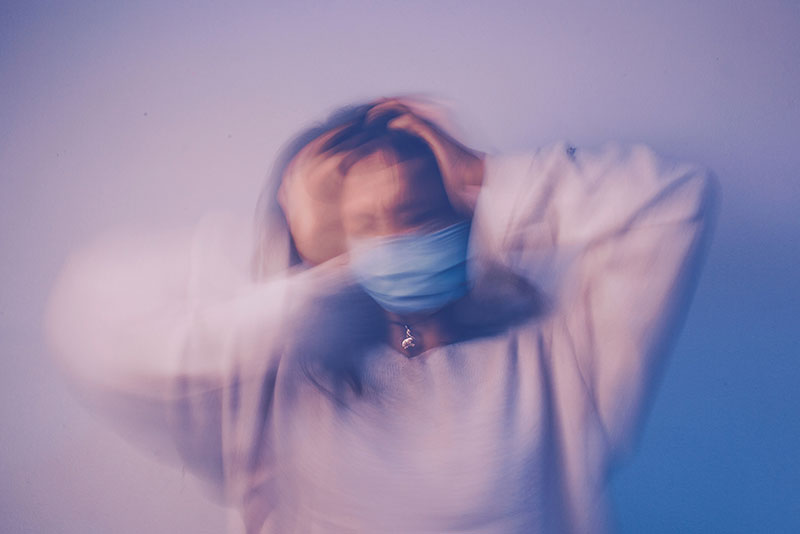By Eleanor Morgan | CONTRIBUTOR |
Since the start of the COVID-19 pandemic, more people are dealing with anxiety than ever before, and for some people it can present as a severe anxiety while others may not spend much time worrying or thinking about it at all. During this global event, we are all exposed to the same situation, but many the impact to each person can be very different.
As part of the human body’s acute stress system, the “fight-or-flight” response works by stimulating the heart rate, dilating air passages, and contracting blood vessels—all of which increase blood flow and oxygen to the muscles, so we can be ready to run away from something life-threatening: a wild mammal, a fast car, a dangerous person. As physiological responses go, it’s pretty important. Only, sometimes, we short-circuit a bit.
Charles Darwin, who for years was reported to have suffered from crippling panic disorder that often left him housebound, argued that, to a degree, it is highly evolved to be “on alert” most of the time. But the fight-or-flight response, as explained by Mark Williams and Danny Penman in Mindfulness: A Practical Guide to Finding Peace in a Frantic World, “isn’t conscious—it’s controlled by one of the most ‘primeval’ parts of the brain, which means it’s often a bit simplistic in the way it interprets danger. In fact, it makes no distinction between an external threat, such as a tiger, and an internal one, such as a troubling memory or a future worry. It treats both as threats that either need to be fought off or run away from.” As the Atlantic‘s editor in chief, Scott Stossel, researched in his brilliant and harrowing memoir, My Age of Anxiety, “Species that ‘fear rightly’ increase their chances of survival. We anxious people are less likely to remove ourselves from the gene pool by, say, frolicking on the edge of cliffs or becoming fighter pilots.”
Sometimes, though, the “dangerous” person is you.
I’ve negotiated anxiety in the form of a panic disorder for the last 15 years. Twice, it’s tipped over into a severe depression—the kind that imprisons you in your flat, unable to do anything but watch The Simpsons on YouTube and eat Carr’s water biscuits.
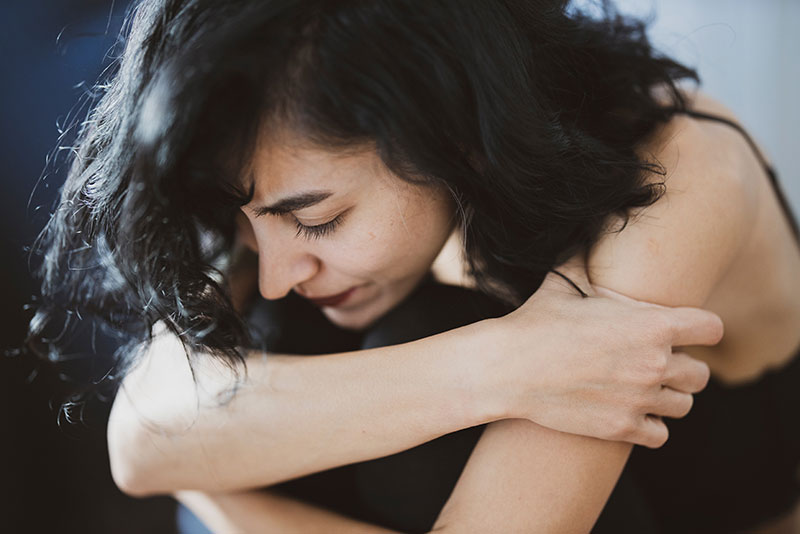
“ Will this be the time it makes me psychotic? Should I call an ambulance? How many sleeping pills would I have to take to sleep for 24 hours but not die?”
These are the kinds of questions I’ve asked myself in the past, stuck in a tornado of negative thought, my ability for rationality sweating out through my armpits while staring at pictures of myself as a child, saying out loud, “Where did she go?” As if there are two versions of me—Version 1.0: Pre-anxious and Version 2.0: Anxious.
Only, it’s not an entirely crackpot theory. Through ongoing CBT therapy I’ve managed to pinpoint the root of my anxiety—a spectacular near-death experience with a burst appendix that swallowed about six months of my life. Turns out that, if you’re a sensitive kid, your body going gangrenous and becoming so weak you have to recuperate in intensive care can have quite an impact on your future mental well being. Particularly when the physical ramifications of said episode have basically ruined your insides forever.
My first taste of panic happened during my first week back at school after appendix-gate. Teachers stopped in the corridors. “Eleanor, are you alright?” they’d ask, in coffee breath whispers. I was chef’s special of the week. But after a few days, something happened.
One afternoon, I started to feel nauseous in biology class. My hands went numb and I felt as if my skull was about to crack like an egg. It was an alien feeling, one with no reference point whatsoever. I went to the toilet and there, for a few minutes, my brain and body weren’t my own. I thought I was going to vomit, but nothing came. Just wave after wave of nauseating pressure, from my temples to my toes. Then came a cold, black fear like I’d never known: my head swam, the walls felt like Silly Putty. Absolutely nothing in my body or surroundings made sense. This was possession, pure and simple.
“ What the fuck is happening to me? Am I dying?”
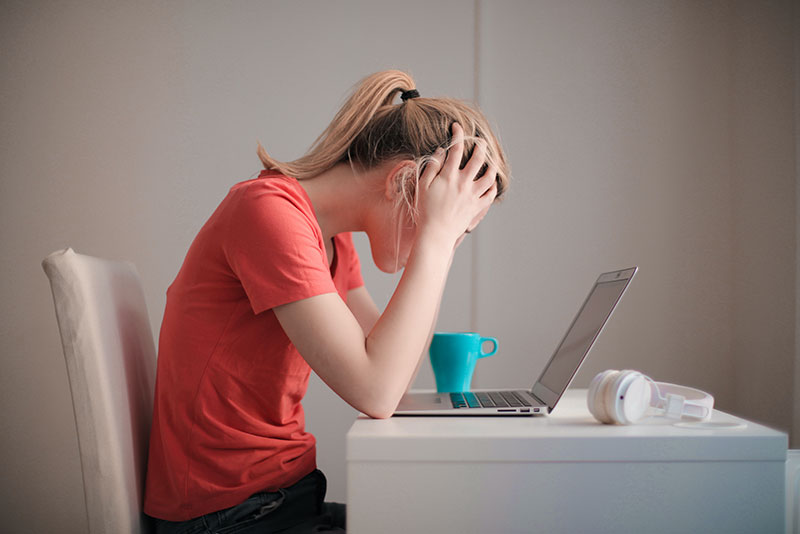
It was my first panic attack, but I didn’t know that then. For the next few weeks, I thought about nothing else. It happened again a few times. At night I’d cry, but telling my parents was out of the question. They just wouldn’t get it—whatever “it” was. I thought it was a physical thing, something related to my damaged insides. But after three weeks of hell and one totally sleepless night, I went to the doctor, alone, who said, “I think you might be having panic attacks,” gave me some leaflets, and referred me to an elderly therapist in the community centre next to the Shell garage.
Every next second and its potential escape route had to be mapped out. Just in case. Anxiety is the “what if” disease
This lady’s approach was to give me some elastic bands to wear on my wrist, telling me to snap them against my skin every time I felt my internal pressure gauge starting to rise. I don’t remember it helping the anxiety itself, but it certainly made me aware that there was a flow of energy that needed to be caught. Somehow.
Months later, I left for university in London with more of an understanding about panic attacks and the claustrophobic loops of anxiety they cause. My parents knew because I had to explain the abundance of fawn-colored elastic in both their houses, and were kind and understanding, but I still lived in constant fear of having one (something I’d later learn was a defining characteristic of panic disorder) when I was out and around other people. Whether I was in lectures, pubs or nightclubs, it never left me. Not for a minute.
Consequently, like many others with the disorder, I developed a pattern of avoidance behaviors relating to where and when I’d felt anxious in the past: “No, dick, you can’t walk through Green Park to get to that lecture because you had a really bad attack there last week,” or, “I know that pub only has one toilet, best give it a miss in case I freak out and there’s a queue, eh?” I’d say to myself in a never-ending internal dialogue—something my current therapist now refers to as “The Chatterbox.” Knowing where the toilets were in every place I was going was an imperative—I had to have somewhere to “escape” to if I started to panic, especially considering that, at the sharp end, my panic mostly manifested with gut issues. If I couldn’t see a toilet, or at least a fire exit sign, I was fucked.
Open spaces were a navigable but daunting prospect and, if I did have to walk through Green Park, say, because my friends did, I’d mentally keep track of all the dense bushes I could hide behind—just in case. I had to sit at the end of the row in every lecture or cinema trip—just in case. If I ever got the tube (an increasing rarity), I’d stand by the door, facing the door—just in case.
Every next second and its potential escape route had to be mapped out. Just in case. Anxiety is a “what if” disease.
Fast forward to the present day and, while I could now write a fucking thesis on living with a panic disorder, I can also tell you that I didn’t make proper, significant progress until a few years ago and that I still find the idea of having a panic attack frightening because, well, how could it not be? Only, that fear is lessened now because I have the techniques to manage the anxiety as it starts to swell, rather than when the wave crashes. I know that if I do have a panic attack I’ll be alright again afterwards, that I’ll deal with it the best I can.
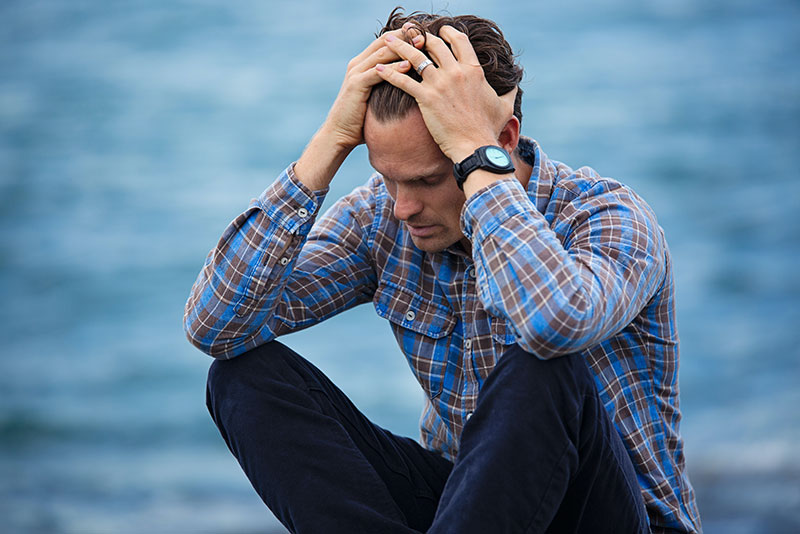
“ Few people today would dispute that chronic stress is a hallmark of our times or that anxiety has become a kind of cultural condition of modernity,” says Stossel. “We live, as has been said many times since the dawn of the atomic era, in an age of anxiety.”
But not everyone has a “normal” response to anxiety.
Panic disorder is an anxiety disorder characterized by recurring panic attacks and an ongoing fear of a panic attack happening. Stats surrounding the prevalence of anxiety disorders in the UK, which were last compiled in 2007, suggested that 1.1 percent of adults (1.3 percent of women, 1 percent of men) met criteria for panic disorder in an adult psychiatric morbidity study. In the US, the number of adults thought to have panic disorder is higher, at 2.7 percent. These, of course, are just the “officially” mentally unwell—my doctor told me recently that anxiety is one of the most frequent complaints she hears from patients. More frequent, sometimes, than coughs and colds.
Panic comes in lots of flavors. It can run the gamut from a gnawing unease in the belly to a fear that feels like being hit by a bullet train. My usual cocktail is a wormy prickling from head to toe, a blanched face, constricted lungs, numb hands and a lurching gut. I feel like I’m going to vomit or shit myself at any second. I have done the former but not, as yet, the latter—despite coming pretty close. It’s a lovely old dance, really.
There have been times where I’ve knelt in alleyways trying to steady my breathing and “hold on” to the ground, to root myself to the physical earth while my body enters what feels like another plane of existence. Anxiety physically manifests in every person differently, though. Some people call ambulances for themselves because it feels like they’re having a heart attack. Others hyperventilate. Others puke. Others shake like they’re standing naked in an Antarctic wind.
There’s the cognitive stuff, too. That got worse as I got older—before, the physical symptoms eclipsed the mental ones. Later, it became a waltzer-car spin of, I am going to explode, I am never going to be safe or normal ever again, my body is failing, everyone is going to see me losing it, I am losing it, I’m losing my mind. This is it. The next step is hard restraints on a psychiatric ward.
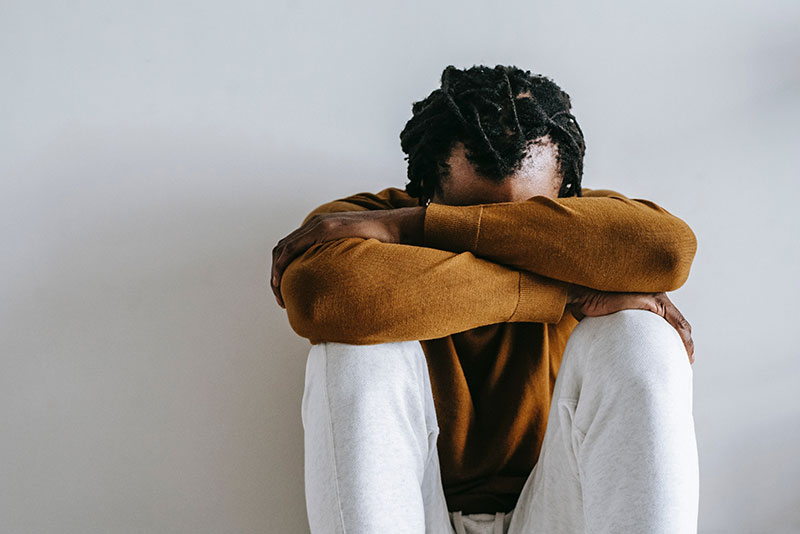
“ I am going to die. This is killing me.”
The carousel doesn’t stop spinning once the anxiety has peaked, either. It surges—albeit less powerfully—a few more times, until it passes. And then the exhaustion grips, with a claw on every finger.
Panic comes in lots of flavors. It can run the gamut from a gnawing unease in the belly to fear that feels like being hit by a bullet train.
At various stages of my life, I’ve had panic attacks every day, more than once a day. My first “breakdown” (therapists discourage us from using that word these days, but that’s what it felt like) in my third year of university built as my fear of having a panic attack became a 24/7 obsession. I feared walking to the Tesco that was 100 yards away, let alone going to lectures. I needed a “get out” plan for every possible eventuality, even if that was just nipping across the road to the corner shop for milk.
Eventually, this much mis-placed adrenalin became unsustainable for my poor old brain. I became very depressed.
Proper depersonalization, the inability to not sleep for 16 hours straight and a total lack of appetite—I lost a stone in three weeks—happened very quickly. I just couldn’t move. After five days of lying still on my bed, listening to Cat Power’s Moon Pix over and over again (I’d read that she wrote it in the midst of a breakdown, so somehow it felt apt) as a summer breeze tapped my neighbor’s eucalyptus tree branches against my window, I became increasingly worried about what to tell my lecturers and parents. Again, I went to my doctor. It took me two hours to get there—there being just over a mile away. He prescribed Sertraline (an SSRI frequently prescribed for anxiety disorders) and diazepam and referred me for therapy—I’d had none since I left for London, despite still spending every day locked in a web of avoidance behaviors and being aware that my salad days were limping by like, well, wet salad. I wasn’t quite “living,” never fully in the moment.
I didn’t like the therapist he referred me to, though. She was very young, spent the entire time box-ticking (literally, on a clipboard) and rarely looked me in the eye. I stopped seeing her after four sessions, thinking, It’s not fucking worth it. I thought that, because both therapists I’d seen in the past hadn’t been able to help me stop my panic attacks in a short space of time, I was immune to help and intervention. I believed this until about three years ago, that I was pretty much treatment-resistant without drugs.

The new medication did nothing miraculous or definitive—I just felt, over time, able to step outside my obsessive thought webs for longer periods, and that in turn helped me to cope, within my parameters. It’s only with hindsight that I can realize what a huge strain I was on my partner at the time, not communicating why I still needed to do and not do certain things. I was deeply ashamed and embarrassed, though, rarely telling anyone what was really going on in my head for fear of sounding “crazy”—even the person I was in a relationship with. In fact, there was only one friend who really knew. Still, I coped, in my own pot-holed way.
I stayed on the antidepressants for a couple of years, making progress in my career quite fast. The fear of having a panic attack or being “caught out” still draped the back of my mind every day, but the curtains had become less heavy. When I would have an attack—one a week, rather than every day—it’d take a few days to get back to normal, but I was alright, really.
I coped when I came off the drugs, too, with another new therapist (older, more mumsy) in tow, until about three years ago. I was going from great job to great job, writing a lot, traveling the world interviewing people I admired. On the surface, I was buoyant; gliding through life like a swan and able to take whatever it threw at me—tense meetings, long-haul flights, tighter and more high-profile commissions. But under the surface it had become chaos again. Paddle paddle paddle, it was. I couldn’t accept that I should have maybe stayed on the antidepressants. In some part of my mind, they were a last resort. The point of almost-failure and the penultimate step before straitjackets and electric shock therapy.
Why did I need a pill that, when I put it between my lips every day, made me think I was an invalid that needed drugs to function properly? So what if my friends were getting increasingly weary of me canceling on them last-minute because I’d had a panic attack en route to meet them and couldn’t imagine moving any further than whichever street corner I was on? Why should they know?
I wasn’t coping, though. That’s the thing and has always been the thing. I was pretending and I needed help. Over the years, I’d become a master of disguise—no one, but no one, could have told you I had an anxiety disorder, save for my inability to get on the tube for more than a couple of stops. If I started to get panicky when out with people, I’d just go home early. Avoidance behavior after avoidance behavior enabled me to live what appeared on the surface to be a normal life. Then, three years ago, I had another breakdown—that word again, but, for me, it’s the only thing that fits. This time it was much worse than before.
It had been building for a while, looking back. I didn’t like my job very much, despite the status and worth it gave me. I’d run out of excuses for flaking on my friends. I needed more bowel surgery—a terrifying prospect for me that my therapist just couldn’t seem to help me rationalize. Traveling for work became increasingly stressful, each airport departure lounge lifting the cloche on a new set of anxiety symptoms. Before going to Kenya for an assignment for the Guardian, I sat in a toilet in Terminal 3 convinced, plain as day, that my neck vertebrae were about to snap in two and paralyze me because the pressure in my head was so strong as my thoughts spun themselves into a tangle.
“ What happens if I have panic attacks in the middle of the Kenyan countryside? Who will help me? What happens if I freak out on the plane and throw up everywhere because I can’t get to the toilet in time? What if I freak out in a part of the world where I know no one and end up being locked away somewhere because no one knows what to do with me?”
What if, what if, what if. It’s exhausting and boring just typing it. Eventually, each panic attack I had would take longer to get over than the last and, over the space of a couple of weeks, they joined up in a constellation of frustration, tears and despair.
I became very depressed again. This time, the “break” was marked by crying, dizziness, and a near total inability to eat, which, for anyone that knows me, would be the most alarming thing of all. I went to bed one night and woke up a different person; someone who couldn’t walk in a straight line, couldn’t stop crying, couldn’t eat a single slice of toast in less than an hour, couldn’t answer the door to the postman, couldn’t run a bath, couldn’t answer the phone, couldn’t feed the cats. Physically, it felt like looking over the edge of the Shard the entire time; a deep vertigo at the very core. I was desperate. Fear had eclipsed everything.
Over the years, I’d become a master of disguise—no one, but no one, could have told you I had an anxiety disorder, save for my inability to get on the tube for more than a couple of stops.
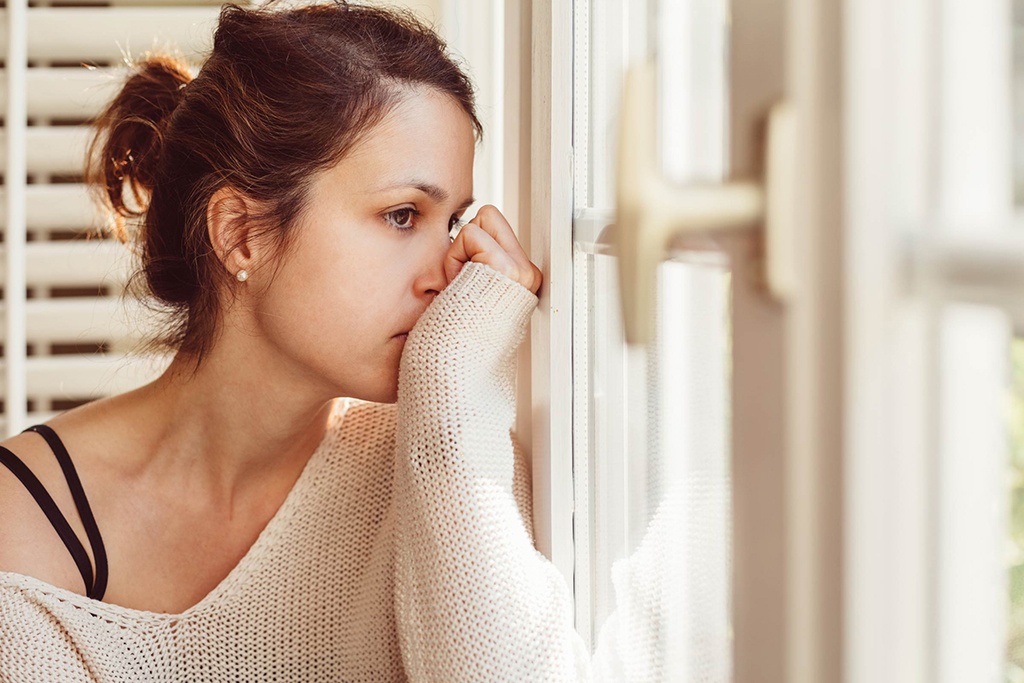
Depression and anxiety often go hand-in-hand. My rational brain knew that, but on the crest of this new terror, I couldn’t accept it. I couldn’t accept that my brain had had enough of being frightened of itself, that depression had become a symptom of my anxiety because it was overloaded. That, to me, was failure. I had failed and I’d never come back. For three weeks, I didn’t go further than the shop at the end of my road and felt, for the first time in my life, rationally suicidal—or, more accurately, desperate for a tangible end to a living hell. I didn’t really want to die, though; I wanted to see the little black eyes of the babies I longed to birth, the arid sands of the deserts I wanted to visit.
I just didn’t want to be living in fear of the next minute.
On the day I found myself staring at the medicine cabinet for a bit too long, working out what might knock me out for a decent amount of time but not leave me needing a stomach pump and a stay in a psychiatric ward, I looked online for the nearest CBT therapist to me. He was less than 300 yards away from my house. Luckily, I was able to see him that same afternoon. He told me, “This is peaking now, you can regain control,” and, despite my legs violently shaking against the chair (a fruity new symptom) and battling the urge to run out of his living room and straight back into my bed, I listened. He was funny, swore a lot, and had an in-depth, scientific knowledge of why the brain behaves as it does, which appealed to me.
That afternoon was my first real turning point in 15 years. After starting out doing two sessions a week with him, I went to my doctor and was prescribed a low dose of a new SSRI—Citalopram, another antidepressant that’s effective in treating anxiety disorders—and, within a month of this intensive, two-pronged approach, along with a commitment to sticking to mindfulness exercises, I began to feel hopeful.
That was three years ago now, and I’m coping. Actually coping, with a demanding full-time job and everything. I’m still on the Citalopram, at a low dose, and am happy to take it indefinitely. Anxiety disorders—like depression—are multicausal, but I’m willing to accept that my brain might have glitched a bit somewhere around the whole nearly dying thing, and that taking medication brings me back up to a livable level of anxiety. I’m happy to believe that. My muscles feel like they’re stuck to my bones. It’s still immensely frustrating sometimes, having this fearful propensity, but I don’t feel like I’m going to dissolve. While once terrified of any kind of branding I’d have as an antidepressant-taker—addict? Failure? Big Pharma lemming?—now I really don’t give a shit who asks. I’m able to live my life. That is the final point to any line of questioning.
People—high-functioning, highly successful people—are crying out to talk about their mental health. Someone just has to push that first domino.
All my friends now know I have a tendency for anxiety and panic attacks and, as with most of these grand revelation–style things you build up in your head, when I “came clean” about the reason I’d been so flaky in the past, none of them were fussed. They still aren’t. People care, deeply, but are generally reasonable once you’ve explained something to them—be it struggling a bit mentally sometimes or tie-dying the hair in your bum crack. They just want to try to understand what you’re saying, offer support, then get on with their lives.
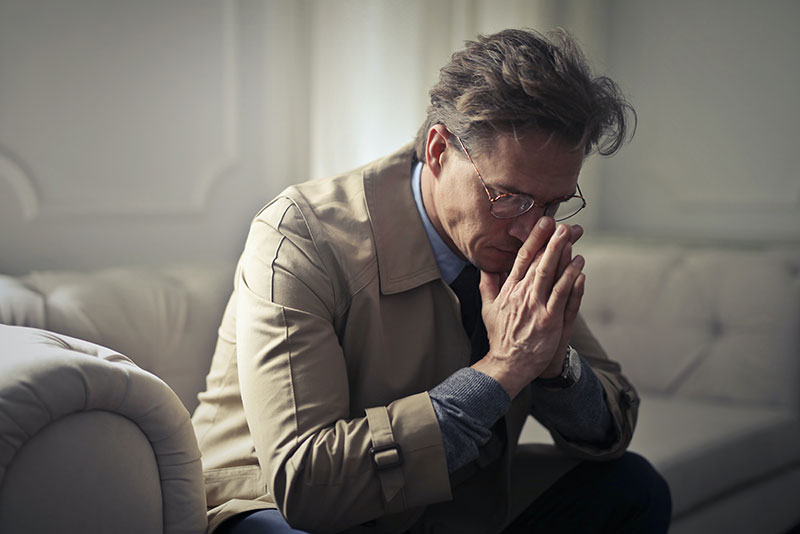
Not talking about our mental health just doesn’t work out well. As Stossel writes, “My current therapist, Dr. W, says there is always the possibility that revealing my anxiety will lift the burden of shame and reduce the isolation of solitary suffering. When I get skittish about airing my psychiatric issues in a book, Dr. W says, “You’ve been keeping your anxiety a secret for years, right? How’s that working out for you?'”
If I can add my own tuppence worth to the conversation, the most crucial thing I’ve learned about treating anxiety is that you need to find a therapist you like. If that means “shopping around” until you find someone you’re comfortable and can completely brain-dump with, and you have the resources to do so (most private therapists offer concessionary rates if you ask), that’s OK. If you are relying on NHS services through your doctor and don’t like or get on with who they refer you to, ask for someone else—it’s your health and you don’t have to stick with someone you feel weird around, just as it’s your right to ask for second opinions with physical illness. Your brain is an organ and it needs proper maintenance when it gets ill. It is, like Louis Theroux said of his own therapy experience when I interviewed him recently, “like looking under the bonnet of a car and seeing what’s going on.”
With this therapist, who I’ll call “S,” I’ve realized that the absolute backbone of me being able to function properly was accepting that there was no “cure” to make me better—only techniques and interventions (in my case, medication) to make life livable. Frustration is too close to anxiety and the constant “WHY THE FUCK IS THIS HAPPENING TO ME” thing, like not talking to anyone, makes it worse. It’s too much pressure.
How did I go from telling no one about my issues to writing in such detail here, you might rightly ask. To which there is a very simple answer: People all over the world plough the internet every day searching for mirrors to their own pain, looking for evidence that people have overcome dire mental discomfort. An echo. When I was unwell, that is all I wanted—some idea that I could come out of those black woods.
It’s a very base idea that being more open about our own experiences with mental illness will encourage others to talk about theirs. But it’s true. Stossel writes about attending a dinner with a bunch of writers and artists in his book, and how, after he’d spoke about its progress, each of the other nine people responded by “telling me a story about his or her own experience with anxiety and medication. Around the table we went, sharing our tales of neurotic woe.”
I’ve been in a similar situation more times than there is to recount here. People—high-functioning, highly successful people—are crying out to talk about their struggles with mental health. No one would feel ashamed discussing an arrhythmia: Why should an instability in the brain be taboo over one in the heart? People want to be heard—someone just has to push that first domino. And this idea that we’ll be “revealing” too much—as I have been fearful of in the past—making people uneasy or run the risk of forever painting ourselves as a “crazy person” by talking about our mental health is so very wrong. It’s question of health full stop. The man who served you your coffee this morning may have overcome cancer a few years ago. Or, he may have overcome a bout of severe, disabling depression. He may have attempted suicide and been sectioned, but you’d have no idea because he has recovered and is getting on with his life the best he can.
See, this is the thing about being human beings: We don’t stay the same. We change, we adapt and we can get better—just as with any other condition. We’re highly evolved like that.
Subscribe to get notifications about future articles.
About the Author: Eleanor Morgan – Contributor


